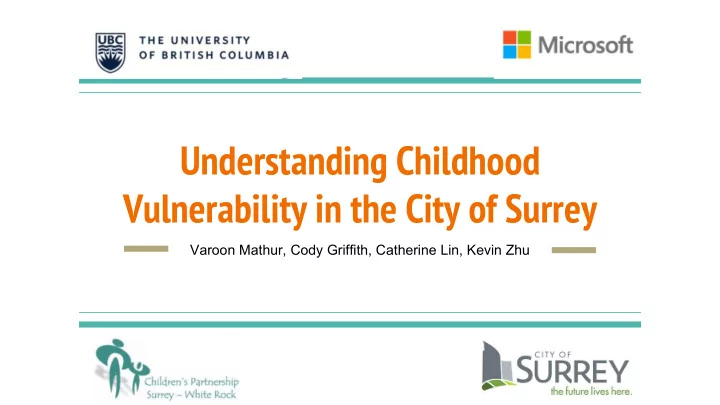

Understanding Childhood Vulnerability in the City of Surrey Varoon Mathur, Cody Griffith, Catherine Lin, Kevin Zhu
- Introduction - Datasets - Top-Down: Understanding Trends of Neighborhoods Overview - Bottom-Up: Understanding City Program Reach - Web Application - Conclusion and Future work
Introduction Understanding the community conditions that best support universal access and improved childhoods outcomes allows ultimately to improve decision making in the areas of planning, and investing across the early and middle years of childhood development. How do we measure this?
● ● Source: Vulnerability of the EDI, The Human Early Learning Partnership ● ● ● ● ●
Two Approaches: Top-Down and Bottom-Up Top-Down : Holistic Measures of Bottom-Up : Granular analysis of City-wide Neighborhood Success in Childhood Program Usage and Registration Data Development Motivated to utilize city-wide data that ● Motivated to understand factors that might better represent ● might correlate with EDI Scores across lived-experiences of children living in neighborhoods (and therefore Surrey childhood vulnerability) Can program/resource utilization ● trends by families be used as an Do neighborhoods that have similar ● EDI Scores across years (waves) indicator for childhood vulnerability? behave the same?
Datasets used Open Source Datasets Private Dataset from Surrey Early Development Instrument CLASS Dataset (160Gb) ● ● (EDI) provided by UBC’s Human Private Dataset - Provided by City Early Learning Partnership (HELP) of Surrey’s Community and for the City of Surrey Recreation Services (CRS) division Statistics Canada 2016 Census Data ● (retrieved through cansim R Package)
Clustering Neighborhoods based on EDI Scores
Single Wave Clusters (t-SNE) for Wave 6 Key Takeaway : t-SNE Approach shows good separation amongst all three clusters for every scale of EDI
Whalley Southwest ● ● ● Newton Semiahmoo Southwest
Clustering Over All Waves (t-SNE) Key Takeaway : t-SNE Approach incorporating all Waves of the EDI show six distinct Clusters.
Whalley Southwest Newton Semiahmoo Southwest
Neighborhood change each wave in relation to Single Wave Clustering
Validating Clustering results with UMAP UMAP Clustering (Right) shows four distinct clusters on all-waves. Hopkins Statistic (Below) to reject the null hypothesis that these clusters reasonably random.
What keeps these Clusters together? Using Census Data to describe Cluster Identity
Analysis of the CLASS Dataset (Program registration for the City of Surrey)
Representation of Neighborhoods in CLASS Dataset Key Takeaway: 4 Neighborhoods ( Surrey City Centre, South Surrey West, Newton East, Cloverdale South) represent approx. 50% of all Data points.
Extracting Child Registration Data from CLASS PostgreSQL Search Terms: High-Level Classification of Courses ● ● - Accounts with registered Birth offered and visible in CLASS: Dates greater or equal to Aquatics ○ Arena and Skating ○ 01/01/2000 Arts and Crafts ○ - Course with a Max Registration Day Camps ○ count >= 1 General Activities ○ - Course must have been completed Music, Dance and Theatre ○ (no Withdrawals) Parent Participation and Family ○ Sports, Fitness and Wellness ○ General Activities: (e.g Arts and General - Children Computer, Arts and General - Children Personal Development, Youth Outdoor Recreation, Youth Personal Development) Parent Participation and Family: (e.g Arts and General - Parent Participation Performing Arts-Arts Centre, Family Environment and Parks)
Distribution of Children’s Age at time of First and Last Registration Key Takeaway: Critical Age of Retention seems to be around 7-8 Years.
Age of First Registration for Male and Female Children
Number of Children Registering for Programs by Season
Distribution of Total Number of Children per Exit Age Key Takeaway: Programs that are classified as ‘General Activities’ present anomalous bimodal distribution of Children exiting, suggesting greater retention rates.
Proportion of Age Groups vs. Last Program Type Key Takeaway: Programs that are classified as ‘General Activities’ present the largest proportion of Children having spent 8 or more years within the Program Pipeline when they leave.
Putting it all Together: A Web Dashboard Application
Visualizing EDI Scores by Neighborhood
Visualizing Cluster Analysis Results
Using Census Data to describe Cluster Variation
Visualizing a Child’s First and Last Registered Program
Conclusions Results from Clustering with t-SNE and UMAP suggests that Clusters are real , and may provide useful in understanding underlying factors that drive Childhood Vulnerability rates (i.e EDI Scores) Ethnicity and SES Census variables emerging as significant discriminants between clusters suggests different groups access programs differently CLASS Analysis suggests that certain Programs and their enrollment can influence retention of Children , allowing for greater engagement of Children within the community and City
Challenges and Future Work When is Machine Learning “appropriate” - In the case of CLASS Dataset, modeling “Exit-Age” to build a predictor makes little sense since the data does not accurately reflect this - Combining the Top-Down and Bottom-Up approaches in a unifying model led to no statistically significant results ( Connecting EDI to CLASS) . Future Work can include - Analyzing Sub-Scale Data for EDI, utilization of MDI as well as future Census Data, and City of Surrey COSMOS Data (e.g Greenspace)
Acknowledgements Stacey Rennie (City of Surrey) - Project Contact and Lead Raymond Ng and Kevin Lin (UBC DSI) Biljana Stojkova, Joe Watson, Carolyn Taylor (UBC ASDA) Pippa Rowcliffe, Barry Forer (UBC HELP) Sarah D’Ettore (Microsoft Vancouver) Patrick Laflamme (UBC Psychology, DSSG ‘17) Thank you so much for your mentorship and guidance!
Recommend
More recommend